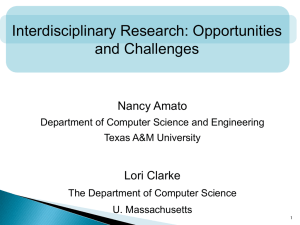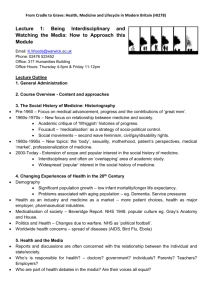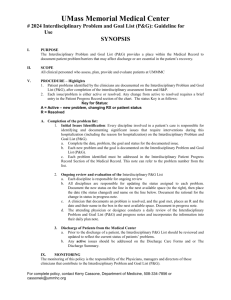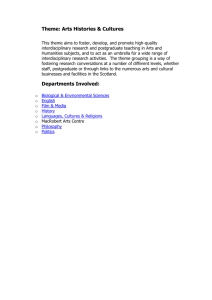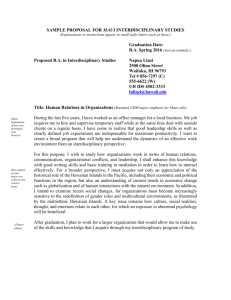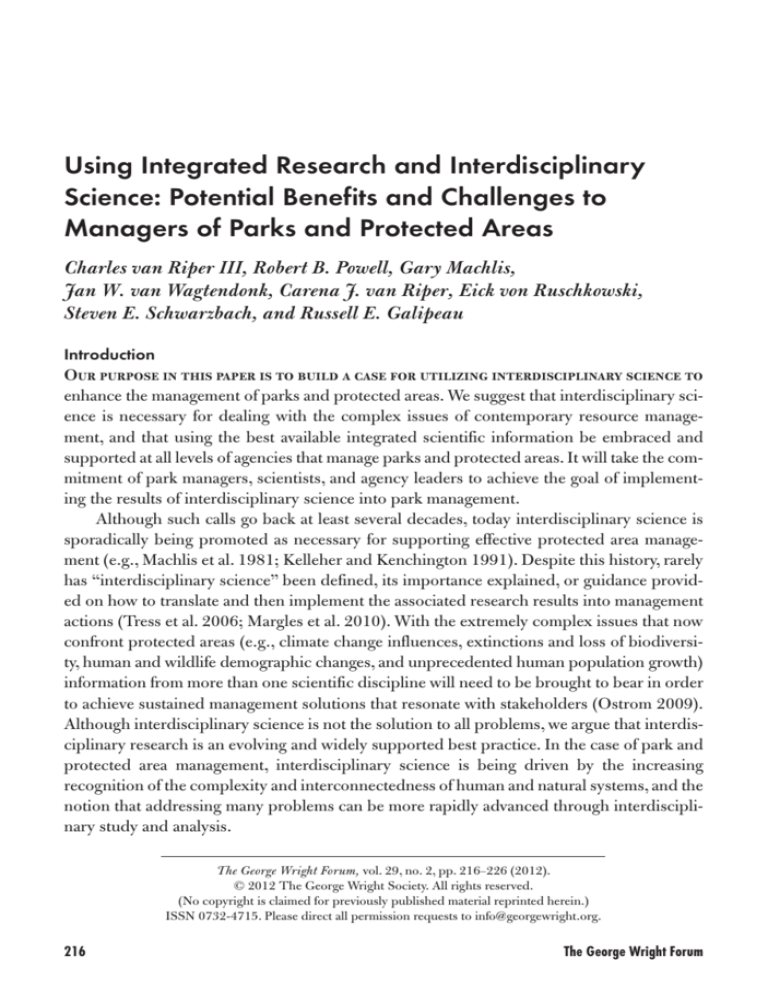
Using Integrated Research and Interdisciplinary
Science: Potential Benefits and Challenges to
Managers of Parks and Protected Areas
Charles van Riper III, Robert B. Powell, Gary Machlis,
Jan W. van Wagtendonk, Carena J. van Riper, Eick von Ruschkowski,
Steven E. Schwarzbach, and Russell E. Galipeau
Introduction
Our purpose in this paper is to build a case for utilizing interdisciplinary science to
enhance the management of parks and protected areas. We suggest that interdisciplinary science is necessary for dealing with the complex issues of contemporary resource management, and that using the best available integrated scientific information be embraced and
supported at all levels of agencies that manage parks and protected areas. It will take the commitment of park managers, scientists, and agency leaders to achieve the goal of implementing the results of interdisciplinary science into park management.
Although such calls go back at least several decades, today interdisciplinary science is
sporadically being promoted as necessary for supporting effective protected area management (e.g., Machlis et al. 1981; Kelleher and Kenchington 1991). Despite this history, rarely
has “interdisciplinary science” been defined, its importance explained, or guidance provided on how to translate and then implement the associated research results into management
actions (Tress et al. 2006; Margles et al. 2010). With the extremely complex issues that now
confront protected areas (e.g., climate change influences, extinctions and loss of biodiversity, human and wildlife demographic changes, and unprecedented human population growth)
information from more than one scientific discipline will need to be brought to bear in order
to achieve sustained management solutions that resonate with stakeholders (Ostrom 2009).
Although interdisciplinary science is not the solution to all problems, we argue that interdisciplinary research is an evolving and widely supported best practice. In the case of park and
protected area management, interdisciplinary science is being driven by the increasing
recognition of the complexity and interconnectedness of human and natural systems, and the
notion that addressing many problems can be more rapidly advanced through interdisciplinary study and analysis.
The George Wright Forum, vol. 29, no. 2, pp. 216–226 (2012).
© 2012 The George Wright Society. All rights reserved.
(No copyright is claimed for previously published material reprinted herein.)
ISSN 0732-4715. Please direct all permission requests to info@georgewright.org.
216
The George Wright Forum
Protected area managers have experienced a recent move toward interdisciplinary science, both from within and outside their organizations (e.g., Myers et al. 2007), and with
considerable encouragement from the scientific community (e.g., NAS 2004). Also, a proper implementation of the International Union for the Conservation of Nature’s protected area
categories (Dudley 2008) requires integrated approaches. Whereas parks and protected
areas worldwide have traditionally been largely managed from a natural resource-based perspective, the recognition of socioeconomic connections between parks and people, or the
questions of governance and management effectiveness, require more complex interdisciplinary scientific research. Managers recognize that such studies are cumbersome to oversee,
the results are often difficult to translate into on-the-ground actions, and both conceptually
and financially can be impeded by a lack of support. Recognizing these challenges, in this
paper we further define interdisciplinary science, discuss its application to park and protected area management, and then examine potential barriers to success. We then close by offering ways of organizing, implementing, and strengthening interdisciplinary science to confront the important issues facing parks and protected areas in the 21st century.
Defining interdisciplinary science
Interdisciplinary science is founded upon the expectation that much of the most important
scientific findings of the future will come from research that spans two or more disciplines.
To understand what is meant by interdisciplinary science and why it is so important to parks
and protected area management, we will first provide definitions, and then the context in
which interdisciplinary science is best practiced. Following are definitions from a 1998 joint
meeting of the US Geological Survey and Ecological Society of America that explored integrated science (see http://www.esa.org/science_resources/programs/past_projects.php).
• Disciplinary science may be characterized by singular efforts within a well-defined specialization. The goal of disciplinary science is a deep understanding of a single problem
or a single aspect of a problem. Although a disciplinary effort may involve many scientists, and the scope of the analysis may be broad, it will still employ the methods and theories of a single discipline.
• Multidisciplinary science is an additive approach that combines the efforts of more
than one discipline. Multidisciplinary efforts seek to combine the results of specialized,
disciplinary approaches for a broader understanding of a problem or question. Cooperation among contributors is necessary.
• Interdisciplinary science is an integrated approach that synthesizes the perspectives of
multiple individual disciplines during all phases of the research to investigate and
answer a question, or solve a problem. It differs from multidisciplinary science in that
integration is required from its genesis. Because of the complexity of the issues that
interdisciplinary research seeks to solve, often new questions emerge as the problem is
further defined and approaches adapted to changing conditions and by systematic trial
and error. Consequently, the results of interdisciplinary efforts may be emergent as well.
Ultimately true collaboration, beyond mere cooperation, is essential for successful interdisciplinary science.
Volume 29 • Number 2 (2012)
217
The distinction between multidisciplinary and interdisciplinary science can be further
refined by stressing the fact that a multidisciplinary approach focuses on breaking down a
problem into unidisciplinary segments, which are solved individually. Interdisciplinary
approaches on the other hand, refrain from making this breakdown but rather stress the
above-mentioned cooperative approach (Kelleher and Kenchington 1991: 28). Others, such
as Tress et al. (2006) and Gray (2008), suggest defining the transfer of research to managers
as “transdisciplinary,” but in this paper we choose to utilize the term “interdisciplinary.” We
believe that interdisciplinary research should also include the transfer of scientific knowledge into management practice of parks and protected areas. Table 1 provides a description
of many of the characteristics of interdisciplinary approaches to research.
Application of interdisciplinary science for parks and protected areas
Today, the health and functioning of protected areas and surrounding landscapes are threatened by a range of human activities (threats and drivers of change) and resulting impacts
such as deforestation, habitat fragmentation, overfishing, a growing disparity in human
wealth, and civil unrest (Daily and Ehrlich 1999; Hassan et al. 2005). Many of these changes
span terrestrial and aquatic systems as well as local, regional, and transboundary spatial
scales, although the actual impact of the threats might vary by geographical region. Successful application of interdisciplinary science maintains flexibility for adaptive changes at multiple scales, while still embracing the complexities of human–environment interactions
(Gunderson and Holling 2001). Understanding and addressing these global trends will not
fall within the exclusive domain of one scientific discipline. As noted by Steffen et al. (2005),
the impact of humankind has emerged as a globally important force that is capable of reshaping the face of the planet:
• Humans have already transformed 40–50% of the ice-free land surface on earth.
• Humans now use 54% of the readily available fresh water on the globe.
• Humans are now an order of magnitude more important at moving sediment than the
sum of all other natural processes operating on the surface of the planet.
• Humans now fix more atmospheric nitrogen than all terrestrial sources combined.
Table 1. Characteristics of interdisciplinary approaches to research.
218
The George Wright Forum
The complexity of our earth system demands new and innovative problem-solving
approaches. E.O. Wilson, one of the world’s most prominent biologists, summarized the situation in this way: “We are drowning in information, while starving for wisdom. The world
will henceforth be run by synthesizers, people able to put together the right information at
the right time, think critically about it, and make important choices wisely” (Wilson 1998:
v). In conclusion, interdisciplinary science is important because there are many crucial links
among research disciplines that can more effectively meld the wide array of scientific knowledge that is needed to effectively address complex park management issues. For interdisciplinary science to prosper in the future, it will need to be clearly demonstrated how science
can address protected area priorities using tools and integrated approaches that provide
answers for decision-makers to answer highly complex, coupled natural and social problems.
Barriers to interdisciplinary science in parks and protected areas
The problems faced by managers of parks and protected areas (from wildlife management
issues through visitor use patterns, to potential impacts of outside development) typically
require the integration of information from many disciplines. Yet there is a strongly held perception that significant barriers exist in conducting interdisciplinary science, what Machlis
et al. (in press) describe as the “standard litany of difficulty.” Many of these perceived barriers are relevant to interdisciplinary science in parks and protected areas, and we will discuss
them in turn.
First, there are disciplinary barriers, which include the challenge of competing and conflicting use of scientific terms and merging scientific paradigms (e.g., biological and social
evolution). Underlying this difference are powerfully held assumptions about natural and
human systems; this lack of mutual understanding can often lead to a lack of mutual respect
among scientists and thus impede a commitment to interdisciplinary practice. The potential
for “disciplinary distrust” (often phrased as “soft versus hard science”) interfering with
interpersonal communications within interdisciplinary research teams is too often realized
(e.g., Naimen 1999; Wear 1999; Bracken and Oughten 2006).
Second, there are institutional difficulties of organization and logistics. These include
the effort required to assemble an interdisciplinary program or project team, the time
demands for learning the rudiments of partner disciplines, and the commitment required to
develop collective understanding and willingness to synthesize new ideas, concepts, theories, methods, data, and conclusions (e.g., Campbell 2005). Within the academic community, the doctoral system at research universities encourages specialization in “disciplinary
stovepipes” (e.g., Golde and Gallagher 1999); even the spatial separation of potential collaborators within the same university, college, or office building can act as a barrier to good
interdisciplinary practice. In park management organizations (such as the US National Park
Service), the institutional separation of biophysical, social, and cultural sciences, and scientific staff and managers varies widely and can (if not managed well) act as an impediment to
effective practice. Funding for interdisciplinary research is also a challenge because the
research is often expensive, risky, and may require a long-time horizon.
A third barrier is the perception that interdisciplinary research is “methodologically
challenged.” In particular, the lack of existing (and robust) conceptual frameworks means
Volume 29 • Number 2 (2012)
219
that theorizing and hypothesis-making is often separated from a clear and articulate interdisciplinary framework (e.g., Kinzig 2001). Similarly, the lack of a common set of protocols,
procedures, and research techniques makes methodologically rigorous interdisciplinary
work even more difficult.
Finally, the challenge can impact individual scientists. The high personal investment
needed to master interdisciplinary science, the long time horizon of many interdisciplinary
projects, the difficulty of acquiring funding, and the career recognition system (skewed to
publishing research results within disciplinary journals) all conspire to add to the litany of
difficulty.
Overcoming barriers to interdisciplinary research
Many of the disciplinary and institutional barriers that we have presented are presently
being overcome through increased recognition regarding the value of interdisciplinary
research, coupled with improved science training and education (Fitzgerald and Stronza
2009). US research organizations such as the National Science Foundation (NSF) and private foundations such as Templeton, Heinz, and Doris Duke have developed programs that
are focused on funding interdisciplinary research and developing new models for graduate
research (NSF 2011). To facilitate interdisciplinary research, universities are developing new
departments, graduate programs, and institutes organized around grand challenges, such as
the School of Sustainability at Arizona State University (see Crow 2010), Integrative Graduate Education and Research Traineeship (IGERT) programs, the Institute for Parks at Clemson University (www.clemson.edu/hehd/departments/prtm/centers-institutes/institute_
for_parks.html/), and, within the US government, with the US Geological Survey’s John
Wesley Powell Center for Analysis and Synthesis (http://powellcenter.usgs.gov/), and many
others. These activities facilitate the formation of interdisciplinary teams that are ready to
work together to address emerging issues. By increasing the support and training in interdisciplinary research, individuals are emerging from graduate school more prepared to collaborate on interdisciplinary research (e.g., Kinzig 2001). Similarly, many national parks and
protected areas have onsite research scientists who can serve as the catalyst for interdisciplinary science by identifying information needs, organizing interdisciplinary teams, and providing critical logistical support. Federal science agencies, such as the US Geological Survey,
can also foster interdisciplinary science because of the large number of discipline specialists
available to form collaborative groups.
Financial resources will continue to be a challenge. If park and protected area managers
are going to use the best available science to inform management decisions, then partnerships and collaborative funding opportunities must be pursued. Increasingly, US federal
agencies are partnering with university researchers to pursue external funds, such as through
NSF, to support important interdisciplinary research. An example is NSF’s Coupled
Human/Natural Systems research competition (NSF 2010). Periodically, emerging national
issues garner the attention of lawmakers and significant funding and new programs are created to address those needs. In some cases, this expansion of opportunity for interdisciplinary science extends to parks and protected areas. For example, in 1998 Congress enacted
the National Parks Omnibus Management Act. This increased funding to the US National
220
The George Wright Forum
Park Service budget, and the appropriations bill in Section 202 set forth a research mandate
for the secretary of the interior to provide for the highest-quality science and its use in decision-making. Other examples include responses to natural and industrial hazards, risk communication, and most recently, climate change. In 2010, many of the US Department of the
Interior land management agencies received significant funding increases for global climate
change activities. In Europe, the European Union (EU) took action to support more integrated, interdisciplinary science approaches as early as 1998, when the 5th Framework Programme, the main EU science-funding scheme for the 1998 to 2004 period, was launched.
Although evaluations showed that in the end, only a minority of funded projects were truly
interdisciplinary, this prepared scientists for future interdisciplinary research (Bruce et al.
2004). Although not exclusively addressing park and protected area issues, the German federal government implemented in 1999 a special funding scheme called “socio-ecological
research,” through which interdisciplinary research groups are encouraged to work on global challenges such as climate change and biodiversity loss. Still, too few of such research programs exist to satisfy the increasing demand for integrated research approaches.
At the individual level, researchers are ignoring or overcoming the disincentives in conducting interdisciplinary research, largely through their passion and motivation to solve
problems and protect our natural and cultural resources. This is coupled with institutional,
organizational, and structural changes, which are now promoting and rewarding interdisciplinary research. An example is the emergence of several important and prestigious journals
(e.g., AMBIO, Conservation Biology, Environmental Conservation, BioScience, etc.) to recognize and publish interdisciplinary research.
At the methodological level, many of the barriers have been eliminated or minimized
through the development of a range of theoretical frameworks such as the human–ecosystem
model (e.g., Machlis et al. 1997), resilience and sustainability (e.g., Folke et al. 2002), and
other systems-type approaches coupled with computational and software advances. Examples of the latter are the increased sophistication of geographical information systems (GIS)
software and statistical packages. The upshot of these changes is that we are seeing increasingly successful and more sophisticated interdisciplinary research that is seeking to find
solutions to ever-more complex issues facing humankind.
Examples of interdisciplinary research in parks and protected areas
One example of interdisciplinary research in parks and protected areas was a project that
drew on conceptual frameworks from the social and natural sciences and was carried out in
the northeastern US. (Monz et al. 2010; van Riper et al. 2011). This research determined the
tradeoffs that park visitors were willing to make among environmental conditions, recreation
use levels, and development at three mountain summits that each had varying biophysical
conditions and a range of recreational opportunities. The findings suggested that visitors
held different preferences for resource impacts, the number of encounters with other visitors, and intensity of management.
Another example is an interdisciplinary project that predicted river flows in Yosemite
National Park, and involved scientists with expertise in biology, sociology, geology, hydrology, climatology, and geography. The onsite biologist had extensive knowledge about the vegVolume 29 • Number 2 (2012)
221
etation, fire history, and visitation of the park, hydrologists contributed detailed synthesis of
stream flow data, geographers provided digital topographic data, geologists had information
of surface and subsurface geologic formations, and climatologists integrated climate data
with all of the other information to develop a predictive model of watershed dynamics. The
model that resulted from the interdisciplinary project will enable park managers to anticipate
annual river flows as well as flood events, and their social and ecological implications.
A third example of interdisciplinary research is an effort along the Mexico–US border
that examined environmental health within the Santa Cruz watershed (Norman et al. 2010;
2011). Given the scarcity of water resources in the desert Southwest, scientists identified
risks to surface water, and the potential consequences to riparian ecosystems and, ultimately, human health. Using an interdisciplinary and integrative approach, social scientists, geographers, hydrologists, biologists, and geologists worked together to track organic and inorganic contaminants and sediment transport. Samples were taken at five protected areas in
Mexico and the US, in an effort to identify contaminant levels in stream sediment, aquatic
macroinvertebrates, aquatic plants (macrophytes), algae, riparian grasses, fish, and birds.
The study identified contributing areas, sources, and transport modes of contaminants and
tracked contaminant movement in surface waters, providing an improved understanding of
the effects of human activities on aquifer dynamics and contaminant transport, and enabled
the development of a model to identify where implementing management practices to abate
pollution could be most effective.
The above examples are only a few of the many interdisciplinary projects now being
conducted in parks and protected areas throughout the world. We use these three projects
only as examples of those that combine various science disciplines such as social, biological,
and physical science to ask what consequence management has for visitor experiences and
perceptions, and on traditional ecological knowledge. These examples also demonstrate
how research can successfully span across disciplinary divides to provide more comprehensive recommendations for managers of parks and protected areas.
Ways forward: Increasing use of interdisciplinary science
In an effort to further advance the use of interdisciplinary science and to improve park and
protected area management, we are suggesting the following:
Develop and integrate research teams that can address complex, interdisciplinary
societal priorities pertaining to parks and protected areas. The nature of societal issues,
such as those identified by Myers et al. (2007), is such that multidisciplinary information—
economic, technological, social, political, and ecological, and their interdisciplinary synthesis—will be needed by decision-makers as they seek effective solutions. The broad array of
scientific expertise within universities, the US Geological Survey, and other science organizations, coupled with the strong resources management and field-based scientific expertise
within the US National Park Service, US Bureau of Land Management, US Fish and Wildlife
Service, and other land management agencies, makes for an ideal situation to provide the scientific information needed to inform future management actions. While each agency has disciplinary strengths, the future requires that these public institutions find ways to integrate
222
The George Wright Forum
them. Together, as a whole, we can provide a service to park management that is greater than
the sum of our parts.
Demonstrate the ability to conduct successful large-scale interdisciplinary science
efforts that address priority issues facing parks. Protected area managers, policy-makers,
and legislators need to be convinced of the benefits of large-scale, complex, interdisciplinary
research, along with the challenges that type of endeavor entails. It is only after having demonstrated an ability to provide a foundation of strong disciplinary science within a large-scale
(e.g., national or regional) multidisciplinary framework, can this effort move forward. Moreover, projects will require strong execution, tangible outcomes, and timely integrated information that support decision-making. With these demonstrated successes, interdisciplinary
science will be more likely embraced by managers of parks and protected areas, and society.
Inform and educate decision-makers, policy-makers, and park and protected area
managers about the benefits of interdisciplinary science. Ongoing communication among
park and protected area managers, scientists, and decision-makers about the complexity of
threats, and the utility of interdisciplinary science to identify potential causes and solutions,
can provide new and useful scientific products and services to managers and decision-makers to meet those threats. Likewise, broadening a partner base that focuses on interdisciplinary science and that also seeks every opportunity to make the public more aware of the benefits of this approach for answering complex scientific questions may also result in similar
outcomes. Finally, improving scientific literacy, and explaining the utility and importance of
interdisciplinary research as a part of leadership training programs, may ensure that future
resource managers and decision-makers consider this approach when facing resource threats
and determining how to manage them.
Conclusion
Interdisciplinary and integrated information coming from economic, technological, social,
political, and ecological arenas will be needed by all park and protected area managers as
they seek effective solutions to today’s complex issues. As issues such as global climate
change and sustainable energy struggle to capture the attention of legislators, park and protected area managers working in concert with scientists need to be prepared with a clear and
compelling multi-year research agenda for interdisciplinary science. This must include a
demonstrated track record of performance, as well as a clearly identified team of scientists
and managers that has the ability to work across disciplines and to quickly respond to emerging threats and issues. Otherwise, new programs and increases in funding will likely not go
toward solving emergent problems in parks and protected areas.
Park managers need to address topics such as resource adaptation to climate change
over a large protected landscape, pinpointing linkages between the environment and human
use patterns while also clarifying the meaning of ecosystem health and restoration. To
address these issues within the core research capabilities of a diverse cross-section of private,
state, and federal research communities, scientists will be communicating with park and protected area managers that oversee lands that can be used as benchmarks and controls from
which to assess human-induced changes to the environment. For many of these important
Volume 29 • Number 2 (2012)
223
societal priorities, “the train has already left the station.” For example, while the global community is struggling to develop meaningful policies that will help mitigate and adapt to climate change, it must also come to terms with:
• The 2011 unrest in the Middle East,
• The rising cost of crude oil, which is moving back over $100 per barrel, forcing and
gasoline prices upward,
• Continued increase of the human population and changing demographics,
• Further changes in land use practices; and
• Instability in the price of key commodities, such as the recent price spike for corn under
expectations of future increases in ethanol production to fulfill sustainable energy goals.
All this is taking place while little is known about the impacts on water availability, ecosystems, and species.
Only by recognizing that we are in a rapidly changing environment, and embracing and
encouraging interdisciplinary science, can park and protected area managers receive the
information necessary to best manage the world’s most valuable natural resources. The
future requires that we find ways to better integrate the findings of interdisciplinary research
into park management. Together, scientists and land managers can provide a service that is
greater than the sum of the parts, and create an identity of leadership and program growth
that addresses large-scale societal needs within parks and protected areas of the world.
References
Bracken, L.J., and E.A. Oughton. 2006. ‘What do you mean?’: The importance of language
in developing interdisciplinary research. Transactions of the Institute of British Geographers 31: 371–382.
Bruce, A., C. Lyall, J. Tait, and R. Williams. 2004: Interdisciplinary integration in Europe:
The case of the Fifth Framework Programme. Futures 36: 457–470.
Campbell, L.M. 2005. Overcoming obstacles to interdisciplinary research. Conservation
Biology 19(2): 574–577.
Crow, M.M. 2010. Organizing teaching and research to address the grand challenges of sustainable development. BioScience 60(7): 488–489.
Daily, G.C., and P.R. Ehrlich. 1999. Managing earth’s ecosystems: An interdisciplinary challenge. Ecosystems 2: 277–280.
Dudley, N., ed. 2008. Guidelines for Applying Protected Area Management Categories. Gland,
Switzerland: IUCN.
Fitzgerald, L., and A. Stronza. 2009. Applied biodiversity science: Integrating ecology, culture, and governance for effective conservation. Interciencia 34(8): 563–570.
Folke, C., S.R. Carpenter, T. Elmqvist, L.H. Gunderson, C.S. Holling, and B. Walker. 2002.
Resilience and sustainable development: Building adaptive capacity in a world of transformations. AMBIO 31(5): 437–440.
Golde, C.M., and H.A. Gallagher. 1999. The challenges of conducting interdisciplinary
research in traditional doctoral programs. Ecosystems 2: 281-285.
224
The George Wright Forum
Gray, B. 2008. Enhancing transdisciplinary research through collaborative leadership.
American Journal of Preventive Medicine 35(2S): S124–S132.
Gunderson, L.H. and C.S. Holling, eds. 2001. Panarchy: Understanding Transformations
in Human and Natural Systems. Washington DC: Island Press.
Hassan, R., R. Scholes, and N. Ash, eds. 2005. Ecosystems and Human Well-being: Current
State and Trends. Findings of the Condition and Trends Working Group. The Millennium Ecosystem Assessment series, vol. 1. Washington, DC: Island Press.
Kelleher, G., and R. Kenchington. 1992. Guidelines for Establishing Marine Protected Areas:
A Marine Conservation and Development Report. Gland, Switzerland: IUCN.
Kinzig, A.P. 2001. Bridging disciplinary divides to address environmental and intellectual
challenges. Ecosystems 4: 709–715.
Machlis,G.E., D. Field, and F. Campbell. 1981. The human ecology of parks. Leisure Sciences 4(3): 195–212.
Machlis, G.E., J.E. Force, and W.R.J. Burch. 1997. The human ecosystem, part 1: The human ecosystem as an organizing concept in ecosystem management. Society and Natural
Resources 10: 347–367.
———. In press. The Structure and Dynamics of Human Ecosystems. New Haven, CT: Yale
University Press.
Margles, S.W., R.B. Peterson, J. Ervin, and B.A. Kaplin. 2010. Conservation without borders: Building communication and action across disciplinary boundaries for effective
conservation. Environmental Management 45(1): 1–4.
Myers, M.D., M.A. Ayers, J.S. Baron, P.R. Beauchemin, K.T. Gallagher, M.B. Goldhaber,
D.R. Hutchinson, J.W. LaBaugh, R.G. Sayre, S.E. Schwarzbach, E.S. Schweig, J. Thormodsgard, C. van Riper III, and W. Wilde. 2007. US Geological Survey updates science
goals for the coming decade. Science 113: 200–201.
Monz, C.A., J.L. Marion, K.A. Goonan, R.E. Manning, J. Wimpey, and C. Carr. 2010.
Assessment and monitoring of recreation impacts and resource conditions on mountain
summits: Examples from the Northern Forest, USA. Mountain Research and Development 30(4): 332–343.
Naiman, R.J. 1999. A perspective on interdisciplinary science. Ecosystems 2: 292–295.
NAS [Committee on Facilitating Interdisciplinary Research, National Academy of Sciences]. 2010. Facilitating Interdisciplinary Research. Washington, DC: National Academy Press.
National Science Foundation. 2010. Dynamics of Coupled Natural and Human Systems
Program Solicitation 10-612. Online at www.nsf.gov/pubs/2010/nsf10612/nsf10612.htm.
———. 2011. Integrative Graduate Education and Research Traineeship Program solicitation 11-533. Online at www.nsf.gov/pubs/2011/nsf11533/nsf11533.htm.
Norman, L., N. Tallent-Halsell, W. Labiosa, M. Weber, A. McCoy, K. Hirschboeck, J. Callegary, C. van Riper III, and F. Gray. 2010. Developing an ecosystem services outline decision support tool to assess the impacts of climate change and urban growth in the Santa
Cruz watershed; where we live, work, and play. Sustainability 2(7): 2044–2069.
Norman, L.M., J. Callegary, C. van Riper III, and F. Gray. 2011. The Border Environmental
Volume 29 • Number 2 (2012)
225
Health Initiative: Investigating the Transboundary Santa Cruz Watershed. USGS FS2010/3097. Online at http://pubs.usgs.gov/fs/2010/3097/.
Ostrom, E. 2009. A general framework for analyzing sustainability of social–ecological systems. Science 325: 419–422.
Steffen, W., A. Sanderson, P.D. Tyson, J. Jäger, P.A. Matson, B. Moore III, F. Oldfield, K.
Richardson, H J. Schellnhuber, B.L. Turner, and R.J. Wasson. 2005. Global Change and
the Earth System—A Planet under Pressure. New York, Springer-Verlag.
Tress, B., G. Tress, and G. Fry. 2006. Defining concepts and the process of knowledge production in integrative research. In From Landscape Research to Landscape Planning:
Aspects of Integration, Education and Application. B. Tress, G. Tress, G. Fry, and P.
Opdam, eds. Wageningen UR Frontis Series vol. 12. Dordrecht, The Netherlands:
Springer, 13–26.
van Riper, C.J., R.E. Manning, C. Monz, and K. Goonan. 2011. Tradeoffs among resource,
social, and managerial conditions on mountain summits of the Northern Forest. Leisure
Sciences 33(3): 228–249.
Wear, D.N. 1999. Challenges to interdisciplinary discourse. Ecosystems 2: 299-301.
Wilson, E. O. 1998. Consilience: The Unity of Knowledge. New York: Alfred A. Knopf.
Charles van Riper III, US Geological Survey SBSC/SDRS, University of Arizona, Tucson,
AZ 85721; charles_van_riper@usgs.gov
Robert B. Powell, Department of Parks, Recreation, and Tourism Management and School
of Agricultural, Forest, and Environmental Sciences, Clemson University, Clemson, SC
29634; rbp@clemson.edu
Gary Machlis, US National Park Service, 1849 C Street NW, Washington, DC 20240; gmachlis@uidaho.edu
Jan W. van Wagtendonk, US Geological Survey Western Ecological Research Center,
Yosemite Field Station, 5083 Foresta Road, El Portal, CA 95318; jan_van_wagtendonk@usgs.gov
Carena J. van Riper, Department of Recreation, Park and Tourism Sciences, Texas A&M
University, College Station, TX 77845; cvanripe@tamu.edu
Eick von Ruschkowski, Leibniz Universität Hannover, Institute of Environmental Planning,
Herrenhäuser Straße 2, 30419 Hannover, Germany; ruschkowski@umwelt.uni-hannover.de
Steven E. Schwarzbach, US Geological Survey Western Ecological Research Center, 3020
State University Drive East, Sacramento, CA 95819; steven_schwarzbach@usgs.gov
Russell E. Galipeau, Channel Islands National Park, 1901 Spinnaker Drive, Ventura, CA
93001 russell_galipeau@nps.gov
226
The George Wright Forum




